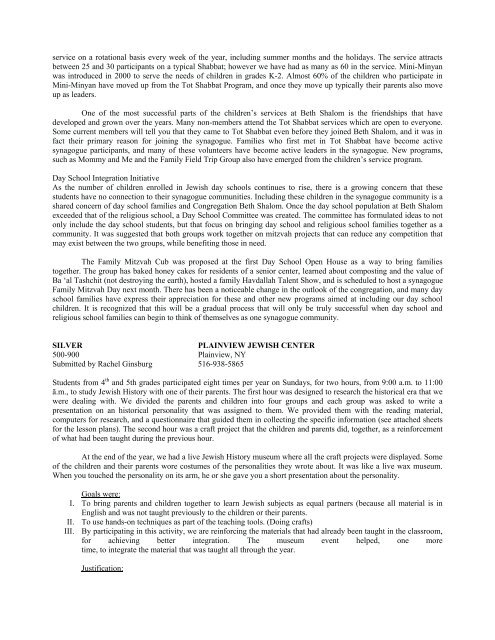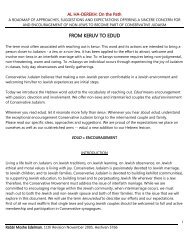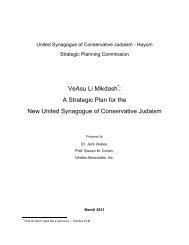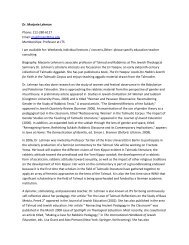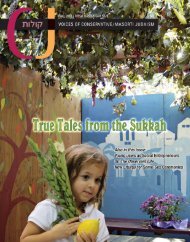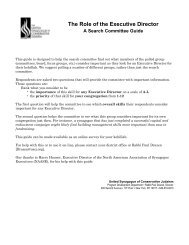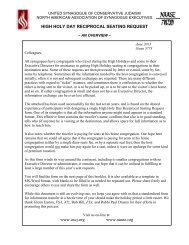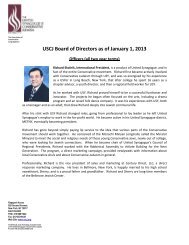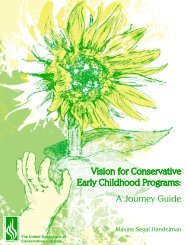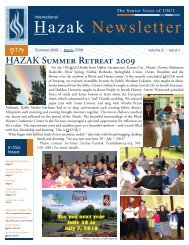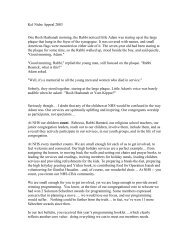2007 - United Synagogue of Conservative Judaism
2007 - United Synagogue of Conservative Judaism
2007 - United Synagogue of Conservative Judaism
You also want an ePaper? Increase the reach of your titles
YUMPU automatically turns print PDFs into web optimized ePapers that Google loves.
service on a rotational basis every week <strong>of</strong> the year, including summer months and the holidays. The service attracts<br />
between 25 and 30 participants on a typical Shabbat; however we have had as many as 60 in the service. Mini-Minyan<br />
was introduced in 2000 to serve the needs <strong>of</strong> children in grades K-2. Almost 60% <strong>of</strong> the children who participate in<br />
Mini-Minyan have moved up from the Tot Shabbat Program, and once they move up typically their parents also move<br />
up as leaders.<br />
One <strong>of</strong> the most successful parts <strong>of</strong> the children’s services at Beth Shalom is the friendships that have<br />
developed and grown over the years. Many non-members attend the Tot Shabbat services which are open to everyone.<br />
Some current members will tell you that they came to Tot Shabbat even before they joined Beth Shalom, and it was in<br />
fact their primary reason for joining the synagogue. Families who first met in Tot Shabbat have become active<br />
synagogue participants, and many <strong>of</strong> these volunteers have become active leaders in the synagogue. New programs,<br />
such as Mommy and Me and the Family Field Trip Group also have emerged from the children’s service program.<br />
Day School Integration Initiative<br />
As the number <strong>of</strong> children enrolled in Jewish day schools continues to rise, there is a growing concern that these<br />
students have no connection to their synagogue communities. Including these children in the synagogue community is a<br />
shared concern <strong>of</strong> day school families and Congregation Beth Shalom. Once the day school population at Beth Shalom<br />
exceeded that <strong>of</strong> the religious school, a Day School Committee was created. The committee has formulated ideas to not<br />
only include the day school students, but that focus on bringing day school and religious school families together as a<br />
community. It was suggested that both groups work together on mitzvah projects that can reduce any competition that<br />
may exist between the two groups, while benefiting those in need.<br />
The Family Mitzvah Cub was proposed at the first Day School Open House as a way to bring families<br />
together. The group has baked honey cakes for residents <strong>of</strong> a senior center, learned about composting and the value <strong>of</strong><br />
Ba ‘al Tashchit (not destroying the earth), hosted a family Havdallah Talent Show, and is scheduled to host a synagogue<br />
Family Mitzvah Day next month. There has been a noticeable change in the outlook <strong>of</strong> the congregation, and many day<br />
school families have express their appreciation for these and other new programs aimed at including our day school<br />
children. It is recognized that this will be a gradual process that will only be truly successful when day school and<br />
religious school families can begin to think <strong>of</strong> themselves as one synagogue community.<br />
SILVER<br />
PLAINVIEW JEWISH CENTER<br />
500-900 Plainview, NY<br />
Submitted by Rachel Ginsburg 516-938-5865<br />
Students from 4 th and 5th grades participated eight times per year on Sundays, for two hours, from 9:00 a.m. to 11:00<br />
ã.m., to study Jewish History with one <strong>of</strong> their parents. The first hour was designed to research the historical era that we<br />
were dealing with. We divided the parents and children into four groups and each group was asked to write a<br />
presentation on an historical personality that was assigned to them. We provided them with the reading material,<br />
computers for research, and a questionnaire that guided them in collecting the specific information (see attached sheets<br />
for the lesson plans). The second hour was a craft project that the children and parents did, together, as a reinforcement<br />
<strong>of</strong> what had been taught during the previous hour.<br />
At the end <strong>of</strong> the year, we had a live Jewish History museum where all the craft projects were displayed. Some<br />
<strong>of</strong> the children and their parents wore costumes <strong>of</strong> the personalities they wrote about. It was like a live wax museum.<br />
When you touched the personality on its arm, he or she gave you a short presentation about the personality.<br />
Goals were:<br />
I. To bring parents and children together to learn Jewish subjects as equal partners (because all material is in<br />
English and was not taught previously to the children or their parents.<br />
II. To use hands-on techniques as part <strong>of</strong> the teaching tools. (Doing crafts)<br />
III. By participating in this activity, we are reinforcing the materials that had already been taught in the classroom,<br />
for achieving better integration. The museum event helped, one more<br />
time, to integrate the material that was taught all through the year.<br />
Justification:


